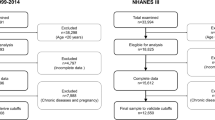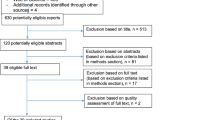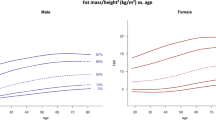Abstract
Background:
Body composition changes with aging lead to increased adiposity and decreased muscle mass, making the diagnosis of obesity challenging. Conventional anthropometry, including body mass index (BMI), while easy to use clinically may misrepresent adiposity. We determined the diagnostic accuracy of BMI using dual-energy X-ray absorptiometry (DEXA) in assessing the degree of obesity in older adults.
Methods:
The National Health and Nutrition Examination Surveys 1999–2004 were used to identify adults aged ⩾60 years with DEXA measures. They were categorized (yes/no) as having elevated body fat by gender (men: ⩾25%; women ⩾35%) and by BMI ⩾25 and ⩾30 kg m−2. The diagnostic performance of BMI was assessed. Metabolic characteristics were compared in discordant cases of BMI/body fat. Weighting and analyses were performed per NHANES (National Health and Nutrition Examination Survey) guidelines.
Results:
We identified 4984 subjects (men: 2453; women: 2531). Mean BMI and % body fat was 28.0 kg m−2 and 30.8% in men, and 28.5 kg m−2 and 42.1% in women. A BMI ⩾30 kg m−2 had a low sensitivity and moderately high specificity (men: 32.9 and 80.8%, concordance index 0.66; women: 38.5 and 78.5%, concordance 0.69) correctly classifying 41.0 and 45.1% of obese subjects. A BMI ⩾25 kg m−2 had a moderately high sensitivity and specificity (men: 80.7 and 99.6%, concordance 0.81; women: 76.9 and 98.8%, concordance 0.84) correctly classifying 80.8 and 78.5% of obese subjects. In subjects with BMI <30 kg m−2, body fat was considered elevated in 67.1% and 61.5% of men and women, respectively. For a BMI ⩾30 kg m−2, sensitivity drops from 40.3% to 14.5% and 44.5% to 23.4%, whereas specificity remains elevated (>98%), in men and women, respectively, in those 60–69.9 years to subjects aged ⩾80 years. Correct classification of obesity using a cutoff of 30 kg m−2 drops from 48.1 to 23.9% and 49.0 to 19.6%, in men and women in these two age groups.
Conclusions:
Traditional measures poorly identify obesity in the elderly. In older adults, BMI may be a suboptimal marker for adiposity.
This is a preview of subscription content, access via your institution
Access options
Subscribe to this journal
Receive 12 print issues and online access
$259.00 per year
only $21.58 per issue
Buy this article
- Purchase on Springer Link
- Instant access to full article PDF
Prices may be subject to local taxes which are calculated during checkout




Similar content being viewed by others
References
Ogden CL, Carroll MD, Kit BK, Flegal KM . Prevalence of childhood and adult obesity in the United States, 2011–2012. JAMA 2014; 311: 806–814.
Flegal KM, Graubard BI, Williamson DF, Gail MH . Excess deaths associated with underweight, overweight, and obesity. JAMA 2005; 293: 1861–1867.
Gregg EW, Cheng YJ, Cadwell BL, Imperatore G, Williams DE, Flegal KM et al. Secular trends in cardiovascular disease risk factors according to body mass index in US adults. JAMA 2005; 293: 1868–1874.
Jensen MD, Ryan DH, Apovian CM, Ard JD, Comuzzie AG, Donato KA et al. 2013 AHA/ACC/TOS Guideline for the Management of Overweight and Obesity in Adults: A Report of the American College of Cardiology/American Heart Association Task Force on Practice Guidelines and The Obesity Society. Circulation 2013; 63: 2985–3023.
Batsis JA, Sahakyan KR, Rodriguez-Escudero JP, Bartels SJ, Somers VK, Lopez-Jimenez F . Normal weight obesity and mortality in United States subjects ⩾60 years of age (from the Third National Health and Nutrition Examination Survey). Am J Cardiol 2013; 112: 1592–1598.
Batsis JA, Singh S, Lopez-Jimenez F . Anthropometric measurements and survival in older americans: results from the third national health and nutrition examination survey. J Nutr Health Aging 2014; 18: 123–130.
Gallagher D, Visser M, Sepulveda D, Pierson RN, Harris T, Heymsfield SB . How useful is body mass index for comparison of body fatness across age, sex, and ethnic groups? Am J Epidemiol 1996; 143: 228–239.
Perloff D, Grim C, Flack J, Frohlich ED, Hill M, McDonald M et al. Human blood pressure determination by sphygmomanometry. Circulation 1993; 88 (Part 1): 2460–2470.
Matthews DR, Hosker JP, Rudenski AS, Naylor BA, Treacher DF, Turner RC . Homeostasis model assessment: insulin resistance and beta-cell function from fasting plasma glucose and insulin concentrations in man. Diabetologia 1985; 28: 412–419.
Dickey R, Bartuska C, Bray G, Callaway W, Davidson EF, Feld S et al. AACE/ACE Position statement on the prevention, diagnosis, and treatment of obesity (1998 revision). Endocr Pract 1998; 4: 300.
Romero-Corral A, Somers VK, Sierra-Johnson J, Thomas RJ, Collazo-Clavell ML, Korinek J et al. Accuracy of body mass index in diagnosing obesity in the adult general population. Int J Obes (Lond) 2008; 32: 959–966.
Peterson MD, Al Snih S, Stoddard J, Shekar A, Hurvitz EA . Obesity misclassification and the metabolic syndrome in adults with functional mobility impairments: Nutrition Examination Survey 2003–2006. Prev Med 2014; 60: 71–76.
Flegal KM, Shepherd JA, Looker AC, Graubard BI, Borrud LG, Ogden CL et al. Comparisons of percentage body fat, body mass index, waist circumference, and waist–stature ratio in adults. Am J Clin Nutr 2009; 89: 500–508.
Okorodudu DO, Jumean MF, Montori VM, Romero-Corral A, Somers VK, Erwin PJ et al. Diagnostic performance of body mass index to identify obesity as defined by body adiposity: a systematic review and meta-analysis. Int J Obes (Lond) 2010; 34: 791–799.
Gomez-Ambrosi J, Silva C, Galofre JC, Escalada J, Santos S, Millan D et al. Body mass index classification misses subjects with increased cardiometabolic risk factors related to elevated adiposity. Int J Obes (Lond) 2012; 36: 286–294.
Pateyjohns IR, Brinkworth GD, Buckley JD, Noakes M, Clifton PM . Comparison of three bioelectrical impedance methods with DXA in overweight and obese men. Obesity (Silver Spring, MD) 2006; 14: 2064–2070.
Romero-Corral A, Somers VK, Sierra-Johnson J, Korenfeld Y, Boarin S, Korinek J et al. Normal weight obesity: a risk factor for cardiometabolic dysregulation and cardiovascular mortality. Eur Heart J 2010; 31: 737–746.
Pasco JA, Nicholson GC, Brennan SL, Kotowicz MA . Prevalence of obesity and the relationship between the body mass index and body fat: cross-sectional, population-based data. PLoS One 2012; 7: e29580.
Taylor RW, Jones IE, Williams SM, Goulding A . Body fat percentages measured by dual-energy X-ray absorptiometry corresponding to recently recommended body mass index cutoffs for overweight and obesity in children and adolescents aged 3–18 y. Am J Clin Nutr 2002; 76: 1416–1421.
Schaap LA, Koster A, Visser M . Adiposity, muscle mass, and muscle strength in relation to functional decline in older persons. Epidemiol Rev 2012; 35: 51–65.
Studenski SA, Peters KW, Alley DE, Cawthon PM, McLean RR, Harris TB et al. The FNIH sarcopenia project: rationale, study description, conference recommendations, and final estimates. J Gerontol Ser A 2014; 69: 547–558.
Centers for Medicare and Medicaid Services. PQRS Measures Codes. 2015. Available from https://www.cms.gov/medicare/quality-initiatives-patients-assessment-instruments/pqrs/measurescodes.html.
Batsis JA, Huyck KL, Bartels SJ . Challenges with the Medicare obesity benefit: practical concerns & proposed solutions. J Gen Intern Med 2015; 30: 118–122.
McAuley PA, Artero EG, Sui X, Lee DC, Church TS, Lavie CJ et al. The obesity paradox, cardiorespiratory fitness, and coronary heart disease. Mayo Clin Proc 2012; 87: 443–451.
Villareal DT, Apovian CM, Kushner RF, Klein S,, American Society for N, Naaso TOS. Obesity in older adults: technical review and position statement of the American Society for Nutrition and NAASO, The Obesity Society. Obes Res 2005; 13: 1849–1863.
Physical status: the use and interpretation of anthropometry. Report of a WHO Expert Committee. World Health Organ Tech Rep Ser 1995; 854: 1–452.
Grundy SM . Obesity, metabolic syndrome, and cardiovascular disease. J Clin Endocrinol Metab 2004; 89: 2595–2600.
Lavie CJ, Milani RV, Ventura HO, Romero-Corral A . Body composition and heart failure prevalence and prognosis: getting to the fat of the matter in the 'obesity paradox'. Mayo Clin Proc 2010; 85: 605–608.
Oreopoulos A, Ezekowitz JA, McAlister FA, Kalantar-Zadeh K, Fonarow GC, Norris CM et al. Association between direct measures of body composition and prognostic factors in chronic heart failure. Mayo Clin Proc 2010; 85: 609–617.
Batsis JA, Lopez-Jimenez F . Cardiovascular risk assessment—from individual risk prediction to estimation of global risk and change in risk in the population. BMC Med 2010; 8: 29.
Cruz-Jentoft AJ, Baeyens JP, Bauer JM, Boirie Y, Cederholm T, Landi F et al. Sarcopenia: European consensus on definition and diagnosis. Age Ageing 2010; 39: 412–423.
Acknowledgements
This work was supported in part by the Dartmouth Health Promotion and Disease Prevention Research Center, which was supported by Cooperative Agreement Number U48DP005018 from the Centers for Disease Control and Prevention. The findings and conclusions in this journal article are those of the authors and do not necessarily represent the official position of the Centers for Disease Control and Prevention. Dr Batsis receives funding from Health Resources Services Administration (UB4HP19206-01-00) for medical geriatric teaching, the Junior Faculty Career Development Award, the Department of Medicine, Dartmouth-Hitchcock Medical Center and the Dartmouth Centers for Health and Aging. Dr Bartels receives funding from the National Institute of Mental Health (K12 HS0217695 (AHRQ), NIMH: T32 MH073553, R01 MH078052, R01 MH089811; R24 MH102794 CDC U48DP005018. Dr Somers receives funding from NHLBI: R01 HL114676-02; R01 HL114024-03; R01 HL065176-12. Dr Lopez-Jimenez: N/A. Dr Mackenzie/Sahakyan: N/A.
Author contributions
Dr Batsis—conception, design, acquisition, analysis, interpretation of data, drafted manuscript, statistical analysis, and material support and obtaining funding; Dr Mackenzie—conception, design, acquisition, analysis, interpretation of data, critical revision of the manuscript for important intellectual content, statistical analysis and supervision; Dr Bartels—conception, design, interpretation of data, critical revision of the manuscript for important intellectual content, administrative, technical or material support and supervision; Dr Sahakyan—interpretation of data, critical revision of the manuscript for important intellectual content, administrative, technical or material support; Dr Somers—interpretation of data, critical revision of the manuscript for important intellectual content, administrative, technical or material support and supervision; Dr Lopez-Jimenez—conception, design, analysis, interpretation of data, critical revision of the manuscript for important intellectual content, administrative, technical or material support and supervision. Drs Batsis and Mackenzie had full access to all the data in the study and takes responsibility for the integrity of the data and the accuracy of the data analysis.
Author information
Authors and Affiliations
Corresponding author
Ethics declarations
Competing interests
The authors declare no conflict of interest.
Additional information
Work presented at the 2015 Gerontological Society of America Conference, Orlando, FL, USA.
Rights and permissions
About this article
Cite this article
Batsis, J., Mackenzie, T., Bartels, S. et al. Diagnostic accuracy of body mass index to identify obesity in older adults: NHANES 1999–2004. Int J Obes 40, 761–767 (2016). https://doi.org/10.1038/ijo.2015.243
Received:
Revised:
Accepted:
Published:
Issue Date:
DOI: https://doi.org/10.1038/ijo.2015.243
This article is cited by
-
Different correlation of body mass index with body fatness and obesity-related biomarker according to age, sex and race-ethnicity
Scientific Reports (2023)
-
Age-appropriate BMI cut-points for cardiometabolic health risk: a cross-sectional analysis of the Canadian Longitudinal Study on Aging
International Journal of Obesity (2022)
-
The Association Between Obesity and Key Health or Psychosocial Outcomes Among Autistic Adults: A Systematic Review
Journal of Autism and Developmental Disorders (2022)
-
The Intersection of Aging and Lung Transplantation: its Impact on Transplant Evaluation, Outcomes, and Clinical Care
Current Transplantation Reports (2022)
-
Metabolic pathways in obesity-related breast cancer
Nature Reviews Endocrinology (2021)



